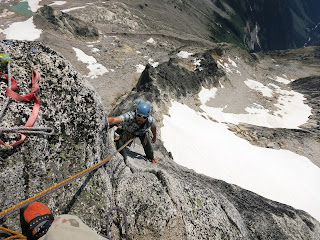After repeating the Beckey-Chouinard on South Howser Tower I spent some time looking through pictures of my original ascent. I'm struck by this picture from my original ascent which was taken at the base as we changed into rock shoes. Specifically, I'm amazed by how big this pack is (35L and filled to the brim). What could I possibly have taken? More specifically, what should I have left out? To answer this question I'm going to compare and contrast the two ascents packing list.
2005: Full shank climbing boots, ice axe, crampon (half set), camelback, food, rain pants and jacket, puffy jacket, soft shell jacket.
2012: Approach shoes, ice axe, crampon (half set), camelback, food, rain pants and jacket, puffy jacket, windbreaker, sil tarp or sleeping bag.
Looking about the packing lists, is I actually brought MORE gear on the second ascent but somehow brought a pack only half the size.
I'm sure most of us have passed somebody on the trail with a massive pack for a short trip and thought "What did they pack?" Here's my theory: It's not the necessary items that make the difference its all the non-essentials that alter pack weight and size. The massive caveat being that doing without a "necessary" item will obviously make a difference. For example I brought approach shoes instead of boots which saved space and weight, and worked given the conditions. Also, we could have done without the sleeping bag and sil-tarp for our planned bivy but would have frozen in the predicted rain.
For a 1-1.5 day climb, aside from basic clothing and whatever gear you're forced to carry over, how much junk could you possibly need? You'll need a couple liters of water (plan on being dehydrated by the end), about 8-10 bars, headlamp, gloves and hat if its ends up being colder than anticipated, blue bag for mid-route deuce, 20 feet of rap tat and that's about it. I would advocate for leaving the ten-essentials at the base and only taking what is needed for upward and downward progress and survival for the interim between the two. Streamline your packing by taking care of tasks ahead of time. Instead of bringing sunscreen make sure to lather up in the morning and leave it in camp. Forget the extra batteries, make sure to put a fresh set in before every big climb. In fact forget anything for which "extra" is written down on the packing list.
A good objective is use everything that you bring on a route and when you get down to the base and say you've done that, then you know you packed well.












.JPG)



























